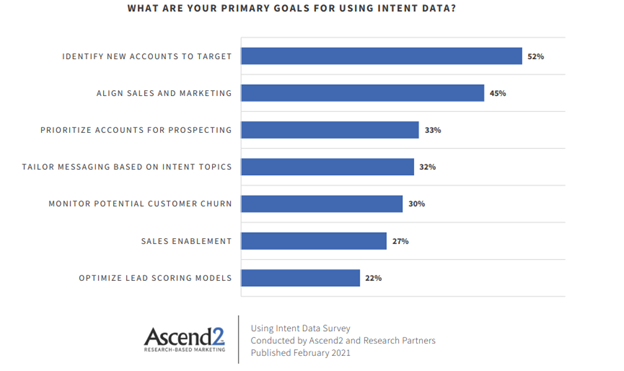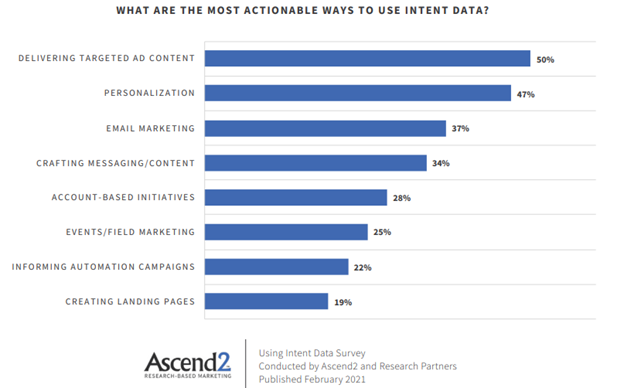Knowing who to target and when is a challenge every marketer must solve. Who is my target audience? Which prospects should be prioritized for marketing resources? Who is most apt to respond to my marketing messages?
Assessing information on who is actively in the market for your products and services is becoming the new gold standard in marketing across industries. While intent data has been discussed for some time in B2B marketing, B2C marketers should also be focused on using intent data in their outreach.
According to new research by Ascend2, 94% of marketers agree that using data to track purchase intent will give marketing and sales teams a competitive advantage in the year ahead.

Nearly seven-in-ten (69%) marketers report being in the midst of planning and rolling out a strategy to use intent data or already have a strategy in place.

What are a marketer’s primary goals for using intent data? According to the research, using intent data enables marketers to identify new prospects and align sales and marketing.

What are the most actionable uses of intent data according to marketers? Half (50%) of marketers agree that intent data is best used as a part of an overall strategy for delivering targeted ad content. Brands are also using intent data to deliver a more personalized experience to prospects and customers according nearly half (47%) of marketers responding to the survey.

Historically, marketers have relied on past purchase history and using predictive modeling, they determine future intent to purchase. However, marketers need a better way to capture in the moment intent.
Alternatively, in the absence of using purchase intent, marketers rely on demographic and lifestyle data. While this is a great technique to drive messaging and more personalized outreach, using demographics alone does not provide the full picture.
Google’s research shows that marketers who try to reach their audience solely on demographics risk missing more than 70% of potential mobile shoppers. For example, 40% of baby product purchasers live in households without children. These may be people buying gifts for birthdays or baby showers.
Google and Micro Moments
Google calls these moments of intent “Micro Moments”. According to Google, Micro Moments are, “intent-rich moments when a person turns to a device to act on a need – to know, go, do, or buy.”
The four types of Micro Moments include:
- I want to know moments: When a user is exploring or researching but isn’t necessarily ready to buy.
- I want to go moments: When a user is looking for a local business or considering making a purchase in a nearby store.
- I want to do moments: When a user is looking for help to get something done or wants to try something new.
- I want to buy moments: When a user wants to make a purchase and needs help deciding what to purchase or how to buy it.
What Does This Mean for Marketers?
Brands can take advantage of these moments by anticipating consumer intentions and then crafting messaging and relevant content to solve their needs. For example, make it easy for consumers to find the information they’re looking for about your brand, products, or services in “I want to know moments.”
Many consumers aren’t brand committed – according to Google, 90% of consumers who use their smartphones for research aren’t absolutely certain of the specific brand they want to buy when they begin looking for information online.
In “I want to go moments”, make sure consumers can easily find your physical presence. 30% of all mobile searches are related to location and your brick-and-mortar store must be easily found through all online channels.
Market to In-Market Consumers with Porch Group Media Signals
In addition to optimizing your presence and strategies to take advantage of these in-the-moment events, consider leveraging an intent solution like Porch Group Media Signals to target consumers who are actively shopping for your products ad services. Porch Group Media’s purchase intent solution captures recent moments so brands can connect with consumers in the market for products and services they sell based on browsing and shopping activity online and in physical stores.
Here is a brief summary of the four components of Porch Group Media Signals
- Reach consumers who are actively browsing online for products you sell. Porch Group Media’s Signals Online product provides visibility into behavioral data and searches occurring on over 90% of internet-connected devices every month.
- Reach shoppers who have recently visited your store or a competitor’s location. Unlike many of the geotargeting solutions in the market today based on targeting a device, our Porch Group Media Mobile solutions allow marketers to market to consumers by name, address, phone, and email and include additional details such as demographics, lifestyle, and contact data.
- Identify unknown visitors on your website and market to them via omnichannel campaigns. Once these consumers are identified through Porch Group Media WebID, marketing campaigns are deployed across email, direct mail, and social through Porch Group Media’s agency services.
- Use Porch Group Media Events to market based on lifestyle changes and trigger data with such as new movers, new children and economic changes. These events are often indicators of high intent to purchase.
Six-in-ten (61%) marketing professionals in Ascend2’s research study reported that they are using both first-party data and third-party data to inform their intent-based marketing strategies.

Contact us to learn how Porch Group Media can help you combine your own, internal data assets with our Porch Group Media Signals technology to skyrocket your success.




